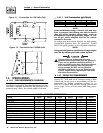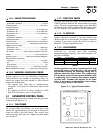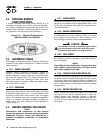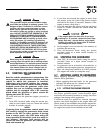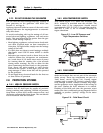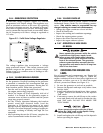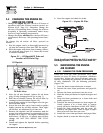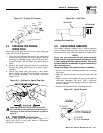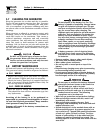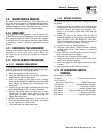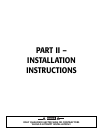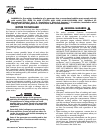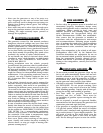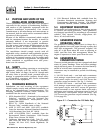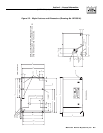
14 Generac
®
Power Systems, Inc.
3.7 CLEANING THE GENERATOR
Keep the generator set as clean and dry as possible.
Protect the unit against excessive dust, dirt, corrosive
vapors, road splash, etc. Permitting dirt and mois-
ture to accumulate on generator windings will have
an adverse effect on the insulation resistance of those
windings.
When moisture is allowed to remain in contact with
windings, some of the moisture will be retained in
voids and cracks in the insulation. This causes a
reduced insulation resistance and will eventually
cause problems. Dirt will make the problem worse,
since dirt tends to hold moisture in contact with
windings. Salt (as from sea air) also will worsen the
problem since it tends to absorb moisture from the
air. Salt and moisture, when combined, form a good
electrical conductor.
Do NOT use a forceful spray of water to clean
the generator. Water will enter the generator
interior and cause problems, and may also cont-
aminate the generator fuel system.
3.8 BATTERY MAINTENANCE
All lead-acid batteries will discharge when not in use.
The generator battery should be inspected as follows:
3.8.1 WEEKLY
• Inspect the battery posts and cables for tightness
and corrosion. Tighten and clean as necessary.
• Check the battery fluid level of unsealed batteries
and, if necessary, fill with Distilled Water Only. Do
not use tap water in batteries.
3.8.2 EVERY SIX MONTHS
• Have the state of charge and condition checked.
This should be done with an automotive-type bat-
tery hydrometer.
NOTE:
Servicing of the battery is to be performed or
supervised by personnel knowledgeable of batter-
ies and the required precautions. Keep unautho-
rized personnel away from batteries.
Damage will result if the battery connections are
made in reverse.
Do not dispose of the battery in a fire. The
battery is capable of exploding. Storage batter-
ies give off explosive hydrogen gas. This gas
can form an explosive mixture around the bat-
tery for several hours after charging. The
slightest spark can ignite the gas and cause an
explosion. Such an explosion can shatter the
battery and cause blindness or other injury.
Any area that houses a storage battery must be
properly ventilated. Do not allow smoking,
open flame, sparks, or any spark producing
tools or equipment near the battery. Discharge
static electricity from your body before touch-
ing the battery by first touching a grounded
metal surface.
A battery presents a risk of electrical shock
and high short circuit current. The following
precautions are to be observed when working
on batteries:
• Remove watches, rings or other metal objects;
• Use tools with insulated handles;
• Wear rubber gloves and boots;
• Do not lay tools or metal parts on top of the
battery;
• Disconnect any charging source prior to connecting
or disconnecting battery terminals; and
• Do not use any jumper cables or booster battery to
crank and start the generator engine. If any battery
has discharged, remove it for recharging.
Do not open or mutilate the battery. Released
electrolyte has been known to be harmful to
the skin and eyes, and to be toxic.
The electrolyte is a dilute sulfuric acid that is
harmful to the skin and eyes. It is electrically
conductive and corrosive. The following
procedures are to be observed:
• Wear full eye protection and protective clothing;
• Where electrolyte contacts the skin, wash it off
immediately with water;
• Where electrolyte contacts the eyes, flush
thoroughly and immediately with water and seek
medical attention; and
• Spilled electrolyte is to be washed down with an
acid neutralizing agent. A common practice is to
use a solution of 1 pound (500 grams) bicarbonate
of soda to 1 gallon (4 liters) or water. The bicar-
bonate of soda solution is to be added until the
evidence of reaction (foaming) has ceased. The
resulting liquid is to be flushed with water and the
area dried.
!
!
DANGER
◆
◆
!
Section 3 – Maintenance
QUIETPACT 55, 65, and 75 Recreational Vehicle Generators



